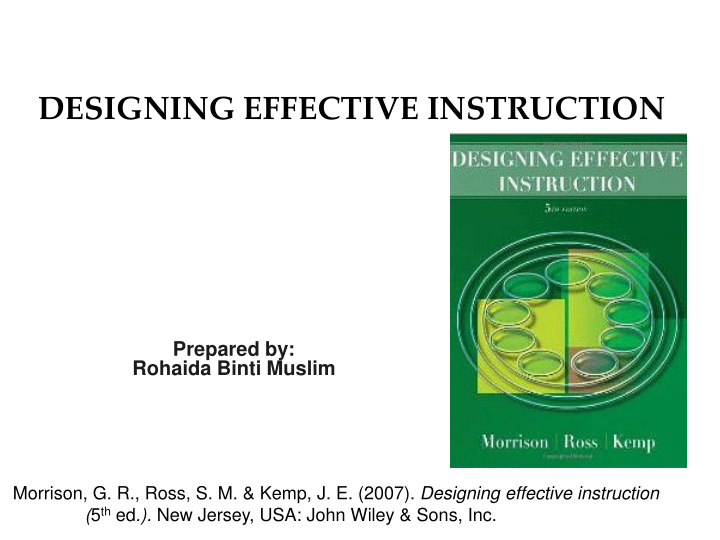



DESIGNING EFFECTIVE INSTRUCTION Prepared by: Rohaida Binti Muslim Morrison, G. R., Ross, S. M. & Kemp, J. E. (2007). Designing effective instruction ( 5 th ed .). New Jersey, USA: John Wiley & Sons, Inc.
Components of the Instructional Design Plan (p. 12)
The Fundamental Components of Instructional Design (p. 15)
A Typical Instructional Design Model (p. 21)
Needs Assessment Process (p. 37)
Interview Questions (p. 40)
Six Steps of Goal Analysis 1. Identify and aim 2. Set goals 3. Refine goals 4. Rank goals 5. Refine goals again 6. Make a final Ranking (pp. 42-43)
Identifying Instructional Problems (p. 46)
Analysis of the Instructional Environment (p. 65)
Content Structure 1. Facts 2. Concepts 3. Principles and rules 4. Procedures 5. Interpersonal skills 6. Attitudes (pp. 78-80)
Taxonomy of Cognitive Objectives (p. 105)
Domain of Psychomotor Objectives (p. 106)
Affective Domain (p. 108)
Learning-Related Sequencing (p. 133)
World-Related Sequencing (p. 135)
Concept-Related Sequencing (p. 136)
Example Fact Strategies (p. 152)
Example Concept Strategies (p. 153)
Example Principle and Rule Strategies Table 7-5 (p. 155)
Example Procedure Strategies Table 7-6 (p. 156)
Example Interpersonal Skills Strategies (p. 159)
Example Attitude Strategies (p. 160)
Preinstructional Strategies (p. 171)
A Simple Memory Model Figure 9-3 (p. 206)
Using Pretests and Posttests to Determine Improvements in Performance (p. 257)
Four Formats in Working with Elementary Schoolchildren 1. Showcase 2. Evaluation 3. Process 4. Documentation (p. 293)
Steps in Planning Formative Evaluations (p. 308)
Stages of Formative Evaluation Table 12-1 (p. 317)
Classical Conditioning (p. 347)
Six Parts of Proposal 1. Statement of purpose 2. Plan of work 3. Milestone and deliverables 4. Budget 5. Schedule 6. Staffing (pp. 374-375)
Six Types of Resources 1. Conceptual resources 2. Influence resources 3. Material resources 4. Personnel resources 5. Institutional resources 6. Time resources (pp. 395-397)

Recommend
More recommend